Sliding Layer Formation during Tribological Contact between Expanded Graphite and Stainless Steel—A Pilot Study
Abstract
1. Introduction
2. Materials and Methods
3. Results and Discussion
3.1. The Formation of a Sliding Layer on Steel under Dry Friction Conditions
3.2. The Formation of a Sliding Layer on Steel under the Conditions of Interaction with Moist Expanded Graphite
3.3. The Comparative Analysis of Dry and Moist Friction on the Sliding Layer Formation
4. Conclusions
- The presence of moisture in the stainless steel-expanded graphite friction node affects the formation of a sliding layer. The resulting layer reduces the surface roughness of the cooperating materials and prevents their accelerated wear. A reduction of the Ra surface roughness parameter of the stainless steel sample was observed for approx. 80% of cases when working with a graphite counter-sample soaked in water, and for approx. 35% of cases when dry working.
- The transfer of graphite material to the surface of the stainless steel sample was observed during static contact of these materials. However, no significant reduction of the Ra surface roughness parameter of the stainless steel sample was observed.
- After 5 min of work with the water-soaked graphite counter-sample, depending on the friction conditions, a reduction of the Ra surface roughness parameter of the stainless steel sample was achieved in the range of 11–18% compared to the initial value. In turn, for dry worked samples, the Ra parameter decreased slightly—by approximately 4%.
- After 30 min of operation, stainless steel samples working with wet expanded graphite were characterized only by a reduction of the Ra surface roughness parameter in the range of 3–25% compared to the initial value. However, the Ra parameter decreased in the range of 5–13% in the case of dry worked samples.
- Pilot studies have shown that operating conditions, i.e., time, load, speed, and humidity, influence the formation of a sliding layer in the tribological contact between stainless steel and expanded graphite. This confirms the validity of conducting further research in this area.
Author Contributions
Funding
Institutional Review Board Statement
Informed Consent Statement
Data Availability Statement
Conflicts of Interest
References
- Holmberga, K.; Erdemir, A. Influence of tribology on global energy consumption, costs and emissions. Friction 2017, 5, 263–284. [Google Scholar] [CrossRef]
- Holmberga, K.; Anderssona, P.; Erdemir, A. Global energy consumption due to friction in passenger cars. Tribol. Int. 2012, 47, 221–234. [Google Scholar] [CrossRef]
- Gong, H.; Yu, C.; Zhang, L.; Xie, G.; Guo, D.; Luo, J. Intelligent lubricating materials: A review. Compos. Part B Eng. 2020, 202, 108450. [Google Scholar] [CrossRef]
- Lima, G.A.; Klein, A.N.; Furlan, K.P. Controlling the Solid-State Reaction in Fe-MoS2 Self-Lubricating Composites for Optimized Tribological Properties. Lubricants 2022, 10, 142. [Google Scholar] [CrossRef]
- Zhu, W.; Tan, Y.; Tang, W.; Li, Y.; Tang, Y. Late-model N, B, and P-co-doped carbon dots as additives for friction-reduction and anti-wear. Diam. Relat. Mater. 2023, 139, 110315. [Google Scholar] [CrossRef]
- Nyholm, N.; Espallargas, N. Functionalized carbon nanostructures as lubricant additives—A review. Carbon 2023, 201, 1200–1228. [Google Scholar] [CrossRef]
- Tang, W.; Liu, H.; Zhu, W.; Wei, X. Carbon nitride quantum dots: Towards efficient nano-additives in polyethylene glycol. Carbon 2023, 207, 305–316. [Google Scholar] [CrossRef]
- Khanmohammadi, H.; Wijanarko, W.; Espallargas, N. The role of tribofilm chemical composition on wear of austenitic stainless steel lubricated with water-glycol containing ionic-liquids as additives. Wear 2023, 520–521, 204672. [Google Scholar] [CrossRef]
- Li, L.; Bai, P.; Wen, X.; Zhou, X.; Ma, K.; Meng, Y.; Ding, J.; Tian, Y. Wear mechanism and evolution of tribofilm of ceramic on steel pairs under ester oil lubrication in wide temperature range. J. Mater. Res. Technol. 2023, 27, 6984–6996. [Google Scholar] [CrossRef]
- Xu, Z.; Zhang, Q.; Huang, X.; Liu, R.; Zhai, W.; Yang, K. An approximate model for the migration of solid lubricant on metal matrix self-lubricating composites. Tribol. Int. 2016, 93, 104–114. [Google Scholar] [CrossRef]
- Zheng, X.; Liu, J.; Du, S.; Zhang, Y. Test and analysis of the tribofilm and surface state during rolling contact under lubrication condition. Tribol. Int. 2023, 187, 108774. [Google Scholar] [CrossRef]
- Huynh, K.K.; Pham, S.T.; Tieu, A.K.; Collins, S.M.; Lu, C.; Wan, S. Tribo-induced catalytically active oxide surfaces enabling the formation of the durable and high-performance carbon-based tribofilms. Tribol. Int. 2023, 184, 108476. [Google Scholar] [CrossRef]
- Solfitia, E.; Bertoa, F. Mechanical properties of flexible graphite: Review. Procedia Struct. Integr. 2020, 25, 420–429. [Google Scholar] [CrossRef]
- Scharf, T.; Prasad, S. Solid lubricants: A review. J. Mater. Sci. 2013, 48, 511–531. [Google Scholar] [CrossRef]
- Li, J.; Peng, Y.; Tang, X.; Liu, B.; Bai, L.; Zhou, K. Hydrogen-passivation modulation on the friction behavior of graphene with vacancy defects under strain engineering. Appl. Surf. Sci. 2022, 579, 152055. [Google Scholar] [CrossRef]
- Wang, L.; Zhang, L.; Tian, M. Effect of expanded graphite (EG) dispersion on the mechanical and tribological properties of nitrile rubber/EG composites. Wear 2012, 276–277, 85–93. [Google Scholar] [CrossRef]
- Li, X.; Gao, Y.; Xing, J.; Wang, Y.; Fang, L. Wear reduction mechanism of graphite and MoS2 in epoxy composites. Wear 2004, 257, 279–283. [Google Scholar] [CrossRef]
- He, X.; Kumara, C.; Sulejmanovic, D.; Keiser, J.R.; Gallego, N.; Qu, J. Tribocorrosion of stainless steel sliding against graphite in FLiNaK molten salt. Wear 2023, 522, 204706. [Google Scholar] [CrossRef]
- Tian, X.-L.; Yu, J.-H.; Qiu, L.; Zhu, Y.-H.; Zhu, M.-Q. Structural changes and electrochemical properties of mesoporous activated carbon derived from Eucommia ulmoides wood tar by KOH activation for supercapacitor applications. Ind. Crops Prod. 2023, 197, 116628. [Google Scholar] [CrossRef]
- Jin, H.; Zhou, K.; Ji, Z.; Tian, X.; Chen, Y.; Lu, L.; Ren, Y.; Xu, C.; Duan, S.; Li, J.; et al. Comparative tribological behavior of friction composites containing natural graphite and expanded graphite. Friction 2020, 8, 684–694. [Google Scholar] [CrossRef]
- Chen, Q.; Morita, T.; Sawae, Y.; Fukuda, K.; Sugimura, J. Effects of trace moisture content on tribofilm formation, friction and wear of CF-filled PTFE in hydrogen. Tribol. Int. 2023, 188, 108905. [Google Scholar] [CrossRef]
- Vishal, K.; Rajkumar, K. Dry sliding wear behavior of Poly Ether Ether Ketone (PEEK) reinforced with graphite and synthetic diamond particles. Diam. Relat. Mater. 2022, 130, 109404. [Google Scholar] [CrossRef]
- Adachi, K.; Cho, U.; Sinha, S.K.; Kato, K. Self-Lubrication by Formation of Graphite Films in the Sliding of Silicon Nitride Against Cast Iron. Tribol. Trans. 2008, 44, 41–46. [Google Scholar] [CrossRef]
- Sugishita, J.; Fujiyoshi, S. The effect of cast iron graphites on friction and wear performance: II: Variables influencing graphite film formation. Wear 1981, 68, 7–20. [Google Scholar] [CrossRef]
- Ghasemi, R.; Elmquist, L. A study on graphite extrusion phenomenon under the sliding wear response of cast iron using microindentation and microscratch techniques. Wear 2014, 320, 120–126. [Google Scholar] [CrossRef]
- Hiratsuka, K.; Mariko, R.; Tsutsumi, T. Effects of sliding speed, periodic pauses, and atmospheric moisture content on the wear of graphite against cast iron. Wear 2019, 424–425, 255–260. [Google Scholar] [CrossRef]
- Parsaeian, P.; Van Eijk, M.C.P.; Nedelcu, I.; Neville, A.; Morina, A. Study of the interfacial mechanism of ZDDP tribofilm in humid environment and its effect on tribochemical wear; Part I: Experimental. Tribol. Int. 2017, 107, 135–143. [Google Scholar] [CrossRef]
- Johansson, P.; Marklund, P.; Björling, M.; Shi, Y. Effect of humidity and counterface material on the friction and wear of carbon fiber reinforced PTFE composites. Tribol. Int. 2021, 157, 106869. [Google Scholar] [CrossRef]
- Zhang, G.; Liu, Y.; Guo, F.; Liu, X.; Wang, Y. Friction Characteristics of Impregnated and Non-Impregnated Graphite against Cemented Carbide under Water Lubrication. J. Mater. Sci. Technol. 2017, 33, 1203–1209. [Google Scholar] [CrossRef]
- Lang, H.; Peng, Y.; Zeng, X.; Liu, L.; Zou, K. Effect of relative humidity on the frictional properties of graphene at atomic-scale steps. Carbon 2018, 137, 519–526. [Google Scholar] [CrossRef]
- Jia, J.; Chen, J.; Zhou, H.; Wang, J.; Zhou, H. Friction and wear properties of bronze–graphite compositeunder water lubrication. Tribol. Int. 2004, 37, 423–429. [Google Scholar] [CrossRef]
- Wos, S.; Koszela, W.; Pawlus, P. The effect of graphite surface texturing on the friction reduction in dry contact. Tribol. Int. 2020, 151, 106535. [Google Scholar] [CrossRef]
- Krawiec, S. Kompozycje Smarów Plastycznych i Stałych w Procesie Tarcia Stalowych Węzłów Maszyn; WPW: Wroclaw, Poland, 2011; pp. 38–45. [Google Scholar]
- Hirani, H.; Goilkar, S.S. Formation of transfer layer and its effect on friction and wear of carbon–graphite face seal under dry, water and steam environments. Wear 2009, 266, 1141–1154. [Google Scholar] [CrossRef]
- Briscoe, W.H.; Titmuss, S.; Tiberg, F.; Thomas, R.K.; McGillivary, D.J.; Klein, J. Boundary lubrication under water. Nat. Lett. 2006, 444, 191–194. [Google Scholar] [CrossRef] [PubMed]
- Ilberg, L.; Manis-Levy, H.; Raveh, A.; Lifshitz, Y.; Varenberg, M. Effect of structure of carbon films on their tribological properties. Diam. Relat. Mater. 2013, 38, 79–86. [Google Scholar] [CrossRef]
- Wang, J.; Yan, F.; Xue, Q. Tribological Behaviors of Some Materials in Sea Water. In Advanced Tribology: Proceedings of CIST2008 & ITS-IFToMM2008; Springer: Berlin/Heidelberg, Germany, 2008; pp. 430–432. [Google Scholar] [CrossRef]
- Somberg, J.; Gonçalves, G.; Emami, N. Graphene oxide versus graphite and chemically expanded graphite as solid lubricant in ultrahigh molecular weight polyethylene composites. Tribol. Int. 2023, 187, 108643. [Google Scholar] [CrossRef]
- Masood, E. Power Generation Technologies. In Steam Power Plants, Components. Power Generation Technologies Foundations, Design and Advances; Elsevier: Amsterdam, The Netherlands, 2023; pp. 205–226. [Google Scholar]
- Sotoodeh, K. Valve sealing and packing. In Prevention of Valve Fugitive Emissions in the Oil and Gas Industry; Gulf Professional Publishing: Houston, TX, USA, 2021; pp. 67–91. [Google Scholar]
- Bloch, H.P.; Geitner, F.K. Repair and maintenance of rotating equipment components. In Practical Machinery Management for Process Plants; Elsevier: Amsterdam, The Netherlands, 2019; pp. 449–518. [Google Scholar]
- Zahorulko, A. Experimental investigation of mechanical properties of stuffing box packings. Seal. Technol. 2015, 8, 7–13. [Google Scholar] [CrossRef]
- Roe, M.; Torrance, A.A. The surface failure and wear of graphite seals. Tribol. Int. 2008, 41, 1002–1008. [Google Scholar] [CrossRef]
- Mordor Intelligence. Report Expanded Graphite Market Size & Share Analysis—Growth Trends & Forecasts (2024–2029); Mordor Intelligence: Hyderabad, India, 2024. [Google Scholar]
- Xu, L.; Tang, Z.; Xu, Z.; Xie, C.; Guo, L.; Li, W. High-performance expanded graphite from flake graphite by microwave-assisted chemical intercalation process. J. Ind. Eng. Chem. 2023, 122, 562–572. [Google Scholar]
- Jenson, A.D.; Roy, S.; Sundararajan, S. The evolution of hardness and tribofilm growth during running-in of case carburized steel under boundary lubrication. Tribol. Int. 2018, 118, 1–10. [Google Scholar] [CrossRef]
- Rewolińska, A.; Perz, K.; Kinal, G. Effect of Steel Surface Roughness and Expanded Graphite Condition on Sliding Layer Formation. Materials 2021, 14, 2960. [Google Scholar] [CrossRef] [PubMed]
- PN-EN ISO 21920-3:2022-06; Product Geometry Specifications (GPS)—Geometric Structure of Surfaces: Profile—Part 3: Specification Operators. Polish Committee for Standardization: Warsaw, Poland, 2022.
- PN-EN ISO 3274:2011; Geometrical Product Specifications (GPS)—Surface Texture: Profile Method—Nominal Characteristics of Contact (Stylus) Instruments. Polish Committee for Standardization: Warsaw, Poland, 2013.
- Rewolińska, A.; Perz, K.; Kinal, G. Graphite expanded as a film-forming material on a steel surface. Tribologia 2017, 5, 81–85. [Google Scholar] [CrossRef]
- Friedrich, K. Polymer composites for tribological applications. Adv. Ind. Eng. Polym. Res. 2018, 1, 3–39. [Google Scholar] [CrossRef]
- Conte, M.; Pinedo, B.; Igartua, A. Frictional heating calculation based on tailored experimental measurements. Tribol. Int. 2014, 74, 1–6. [Google Scholar] [CrossRef]
- Zhu, J.; Xie, F.; Dwyer-Joyce, R.S. PEEK Composites as Self-Lubricating Bush Materials for Articulating Revolute Pin Joints. Polymers 2020, 12, 665. [Google Scholar] [CrossRef] [PubMed]
- Restuccia, P.; Ferrario, M.; Righi, M.C. Monitoring water and oxygen splitting at graphene edges and folds: Insights into the lubricity of graphitic materials. Carbon 2020, 156, 93–103. [Google Scholar] [CrossRef]
- Savage, R.H. Graphite lubrication. J. Appl. Phys. 1948, 19, 1–10. [Google Scholar] [CrossRef]
- Morstein, C.E.; Klemenz, A.; Dienwiebel, M.; Moseler, M. Humidity-dependent lubrication of highly loaded contacts by graphite and a structural transition to turbostratic carbon. Nat. Commun. 2020, 13, 5958. [Google Scholar] [CrossRef] [PubMed]

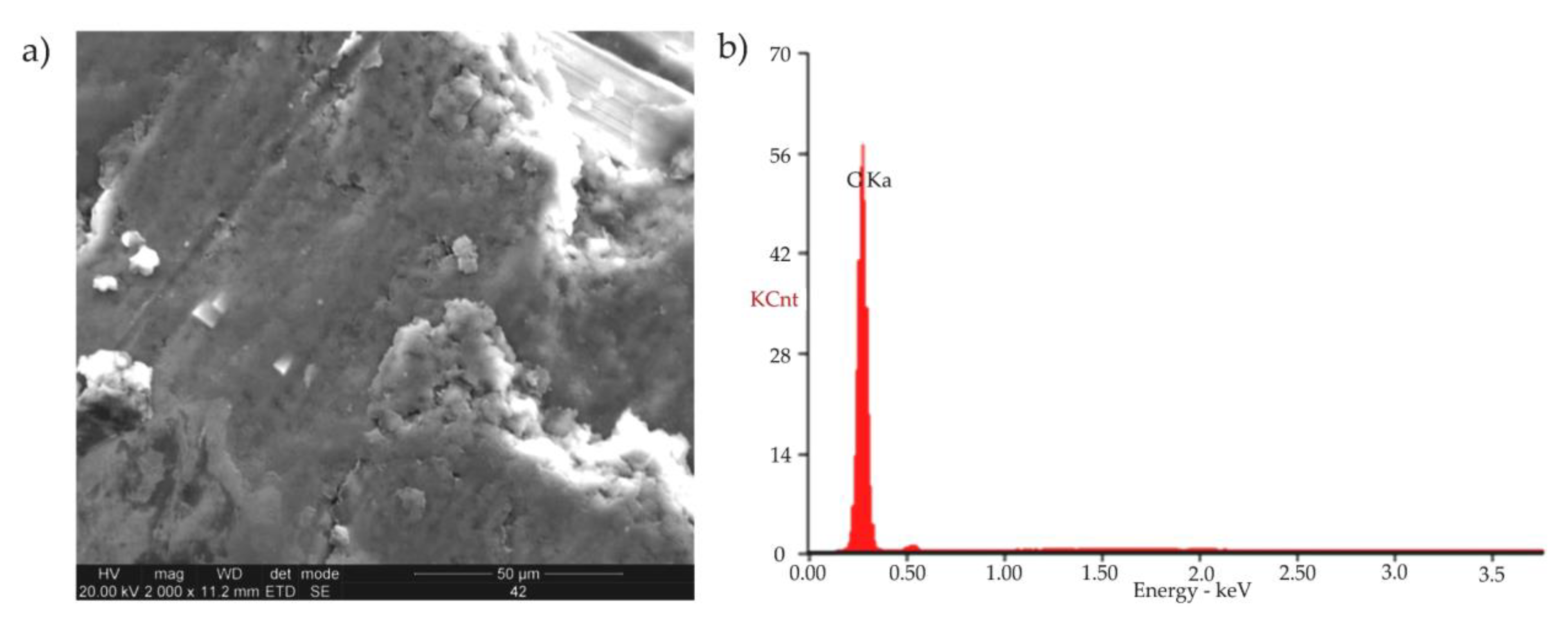


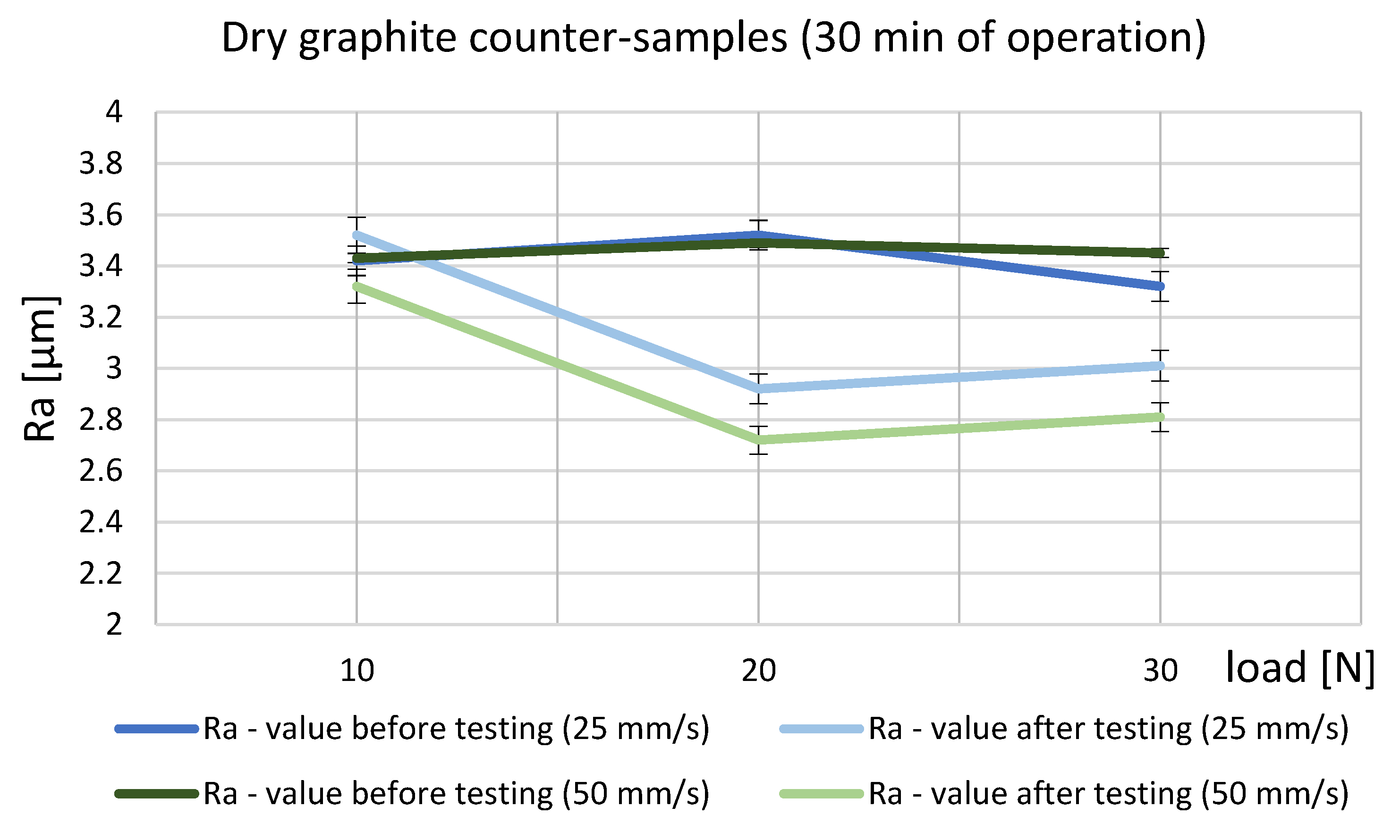
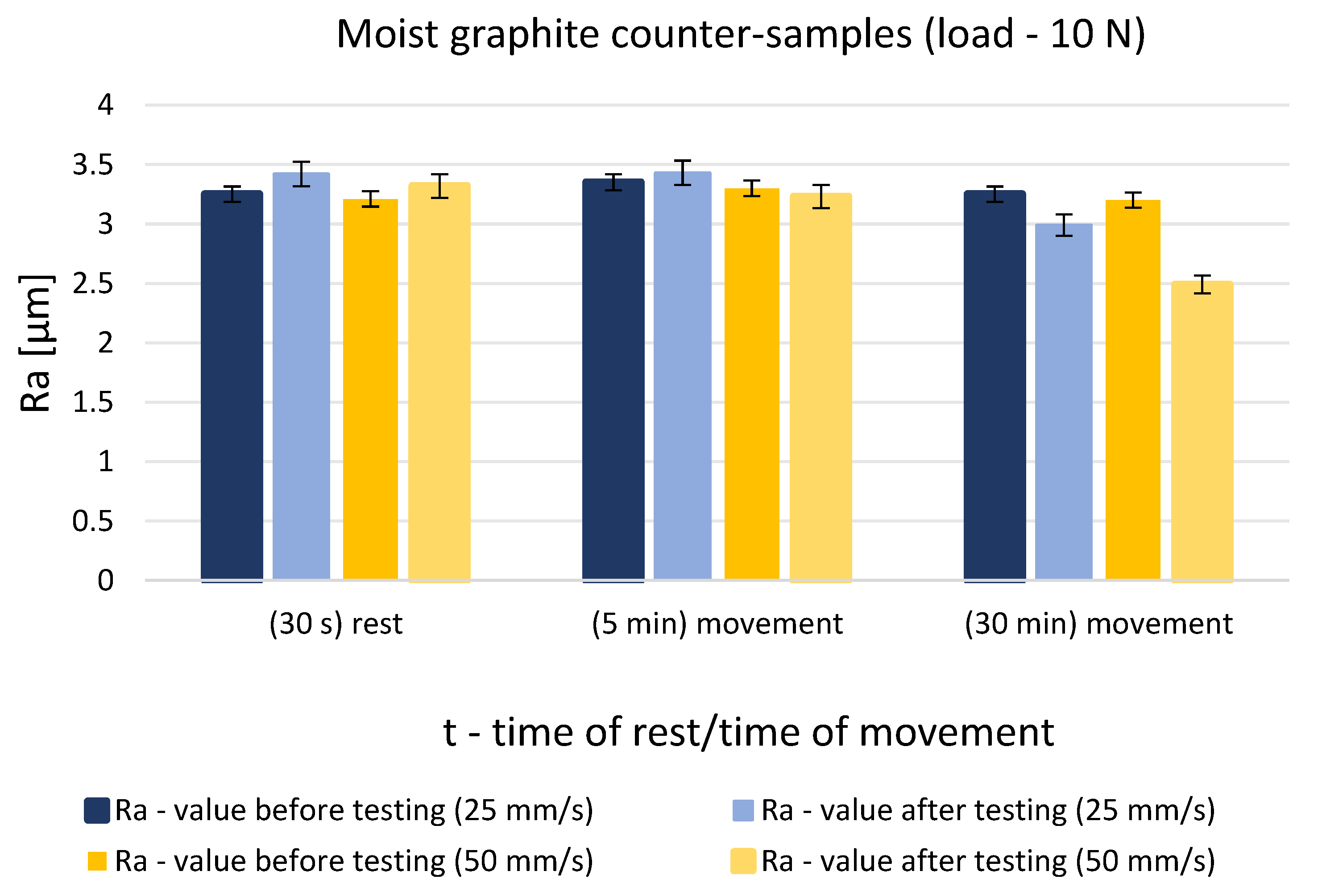

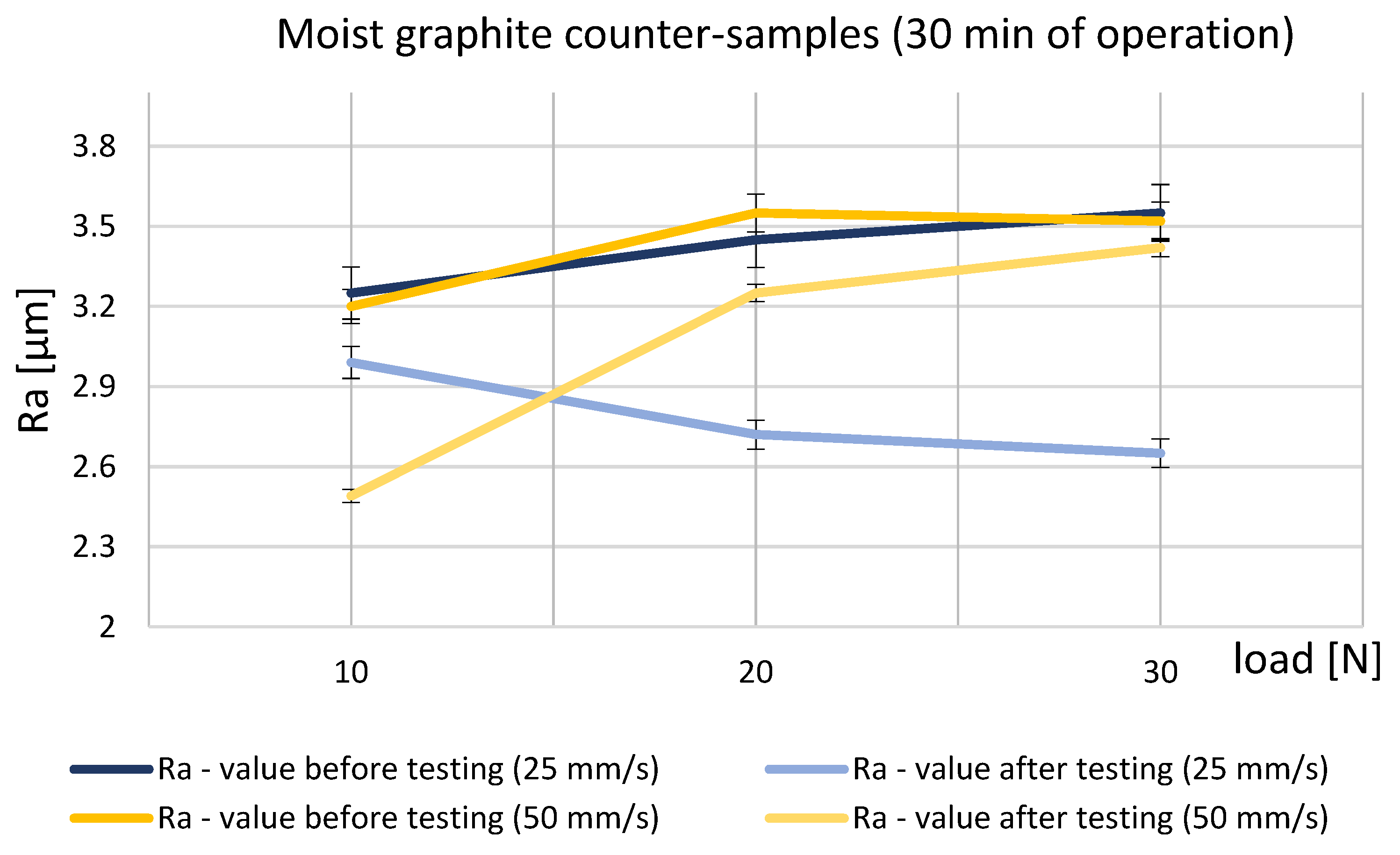
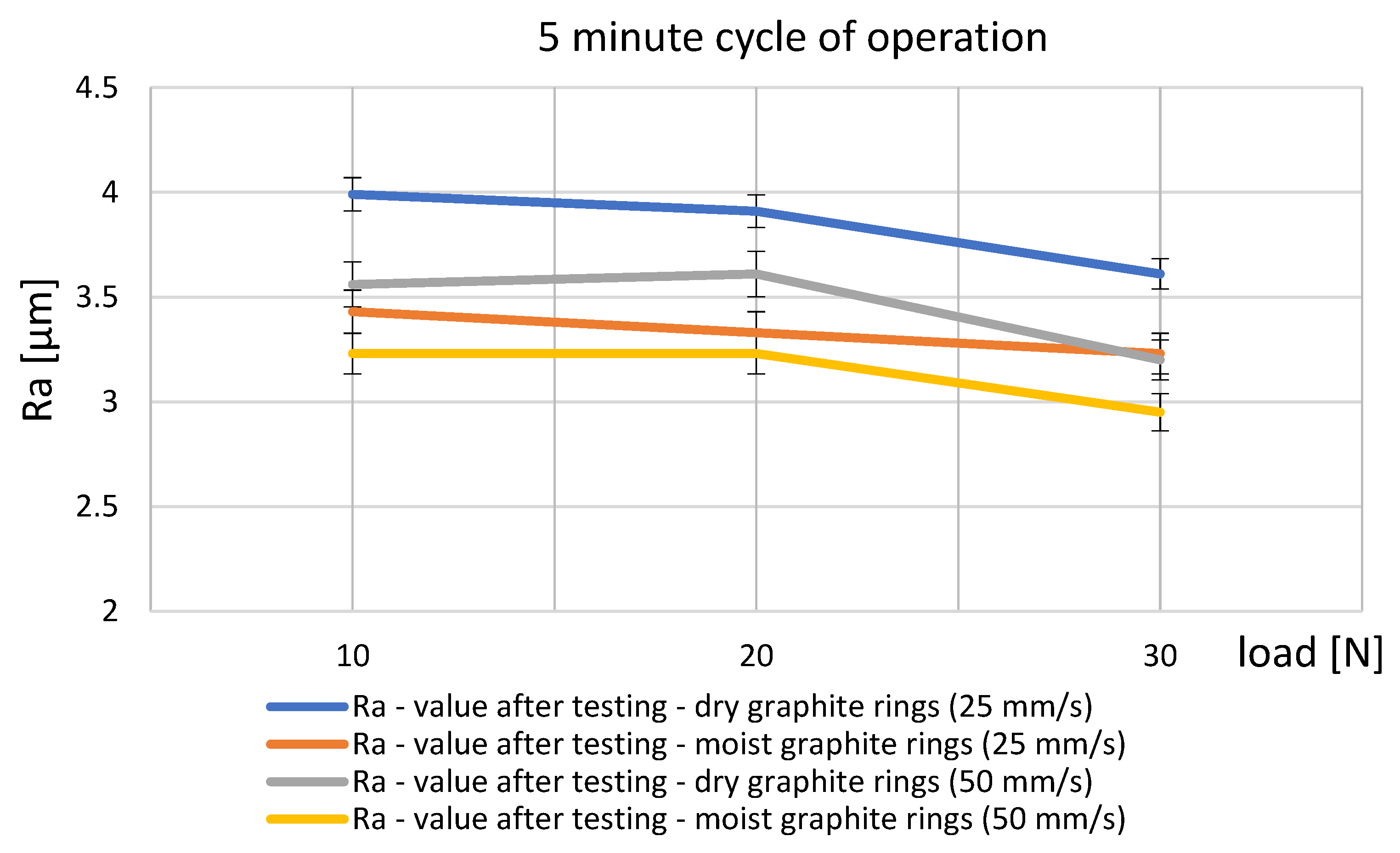


| Counter-Sample | Sample | |
|---|---|---|
| Material (chemical composition) | expanded graphite (C-98.9%) | stainless steel (AISI 304—C-0.08, Cr-18.2, Ni-10.5, Fe-65.91, Mn-1.2, P-0.04, Si-0.48) |
| Shape | ring | tapered head rivet |
| Dimensions [mm] | ϕ60 × 40 × 10 | ϕ10 × 30 |
| Density [g/cm3] | 1.6 | 7.8 |
| Roughness Ra [μm] | - | 3.21–3.64 |
| Hardness [HRC] | - | 29–30 |
| Expansion [mL/h] | 200 ÷ 300 | - |
| Tensile strength [MPa] | - | Rm = 520 |
| Yield strength [MPa] | Rp = 210 |
| Operating Conditions | Test Duration | ||
|---|---|---|---|
| Rest [s] | Movement [min] | ||
| Dry counter-sample | 30 | 5 | 30 |
| Moist counter-sample | |||
| Operating Conditions of the Friction Node | |||||
|---|---|---|---|---|---|
| Speed [mm/s] | |||||
| 25 | 50 | ||||
| Load [N] | |||||
| 10 | 20 | 30 | 10 | 20 | 30 |
| The Steel Samples Working with Dry Graphite Counter-Samples | ||||||||||||
|---|---|---|---|---|---|---|---|---|---|---|---|---|
| Speed [mm/s] | 25 | 50 | ||||||||||
| Load [N] | 10 | 20 | 30 | 10 | 20 | 30 | ||||||
| Roughness parameters Ra [μm] | ||||||||||||
| b * | a ** | b | a | b | a | b | a | b | a | b | a | |
| Rest (30 s) | 3.33 | 3.31 | 3.31 | 3.32 | 3.23 | 3.36 | 3.22 | 3.31 | 3.36 | 3.42 | 3.23 | 3.36 |
| Movement (5 min) | 3.57 | 3.99 | 3.47 | 3.91 | 3.49 | 3.61 | 3.45 | 3.56 | 3.41 | 3.61 | 3.33 | 3.20 |
| Movement (30 min) | 3.42 | 3.52 | 3.52 | 2.92 | 3.32 | 3.01 | 3.42 | 3.32 | 3.49 | 2.72 | 3.45 | 2.81 |
| The steel samples working with moist graphite counter-samples | ||||||||||||
| Rest (30 s) | 3.25 | 3.42 | 3.20 | 3.31 | 3.43 | 3.21 | 3.21 | 3.32 | 3.21 | 3.40 | 3.44 | 3.31 |
| Movement (5 min) | 3.35 | 3.43 | 3.34 | 3.23 | 3.34 | 3.23 | 3.30 | 3.23 | 3.35 | 3.23 | 3.41 | 2.95 |
| Movement (30 min) | 3.25 | 2.99 | 3.45 | 2.72 | 3.55 | 2.65 | 3.20 | 2.49 | 3.55 | 3.25 | 3.52 | 3.42 |
Disclaimer/Publisher’s Note: The statements, opinions and data contained in all publications are solely those of the individual author(s) and contributor(s) and not of MDPI and/or the editor(s). MDPI and/or the editor(s) disclaim responsibility for any injury to people or property resulting from any ideas, methods, instructions or products referred to in the content. |
© 2024 by the authors. Licensee MDPI, Basel, Switzerland. This article is an open access article distributed under the terms and conditions of the Creative Commons Attribution (CC BY) license (https://creativecommons.org/licenses/by/4.0/).
Share and Cite
Rewolińska, A.; Leksycki, K.; Perz, K.; Kinal, G. Sliding Layer Formation during Tribological Contact between Expanded Graphite and Stainless Steel—A Pilot Study. Appl. Sci. 2024, 14, 4497. https://doi.org/10.3390/app14114497
Rewolińska A, Leksycki K, Perz K, Kinal G. Sliding Layer Formation during Tribological Contact between Expanded Graphite and Stainless Steel—A Pilot Study. Applied Sciences. 2024; 14(11):4497. https://doi.org/10.3390/app14114497
Chicago/Turabian StyleRewolińska, Aleksandra, Kamil Leksycki, Karolina Perz, and Grzegorz Kinal. 2024. "Sliding Layer Formation during Tribological Contact between Expanded Graphite and Stainless Steel—A Pilot Study" Applied Sciences 14, no. 11: 4497. https://doi.org/10.3390/app14114497
APA StyleRewolińska, A., Leksycki, K., Perz, K., & Kinal, G. (2024). Sliding Layer Formation during Tribological Contact between Expanded Graphite and Stainless Steel—A Pilot Study. Applied Sciences, 14(11), 4497. https://doi.org/10.3390/app14114497








